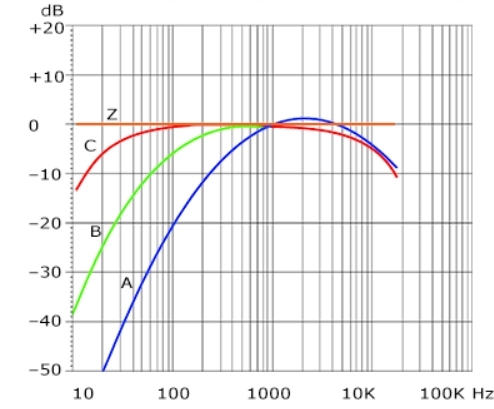Sound Level Frequency Weightings : A, B, C, D, Lin, Z ....
Frequency Weighting Filters correlate sound level meter objective measurements with the subjective human response.
Our ears are frequency selective, being most sensitive between 500 Hz and 6,000 Hz, compared with our overall hearing range from 20 Hz up to 20,000 Hz.
Our subjective response is also loudness dependent, so early sound level meters included A, B, C and Linear or Flat frequency-weightings to take both factors into account. At one stage D-weighting filters were also popular for rating aircraft noise levels.
A, B, C and Z Frequency Weighting Filters

A-weighting is the 'common' name for frequency-weighted sound levels, measured over the 'A' frequency range, shown in the above graph and compatible with the loudness rating of low and medium sound levels. The graphs are based on the 'pure tone' equal loudness contours.
The preferred convention is to write LA = x dB where x is the measured sound pressure level in decibels. However x dBA and x dB(A) are often used, as are LAeq and LAFmax.
A-weighted measurements correlate well with the perceived noise level in many applications, as originally intended. However the current use of the A-weighting for most environmental noise applications, supported by regulations, does cause concern in some quarters, bearing in mind the IEC Loudness Definition and related topics.
See also
LA • LA10 • LA90 •
LAE •
LAeq •
LAF • LAmax etc..
B-weighting, no longer in common use, was initially developed to cover the mid-range loudness scale. It was more 'critical' of lower frequencies than the A-weighting network which probably accounts for it's use by the motor industry for many years after it's decline in general popularity.
C-weighting is used for high level measurements and peak sound pressure levels, approximately following the 100 phon curve and reported as dBC, dB(C) or LC, LCE, LCeq etc., = x dB
The A-weighting curve is used extensively for general purpose noise measurements but the C-weighting correlates better with the human response to high noise levels and therefore noise induced hearing loss.
D-weighting developed for measuring aircraft noise especially non-bypass military engines.
No longer in common use since IEC 61672 2003, more recent ISO standards recommend A-weighting for commercial aircraft noise.
Flat weighting, no longer appears in the Standards, which prefer the newer Z-weighting.
L, Lin and Linear-weightings, are similar to the Flat Weighting above, also superseded by the Z-weighting.
Z-weighting, the Z is for 'zero' frequency-weighting, implying no weighting across the audio spectrum. In reality the range is 10 Hz to 20 kHz ±1.5 dB.
Introduced in 2003 (IEC 61672) to replace the Flat or Linear Filters.
See examples of Z-weighted sound levels LZeq, LZF, LZS, etc.
See also vibration weighting networks
